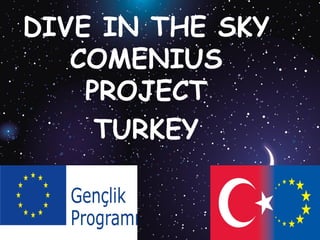
Turkey activities
- 1. DIVE IN THE SKY COMENIUS PROJECT TURKEY
- 2. WORKS Context Thanks Our activities Constellations Exoplanets Are we alone?
- 7. Our Activities • Our first activity was to take our own original photos of full moon or stars with telescopes. All forth graders participated this contests.It was great chance to observe the sky for us
- 22. Our teacher Rana Karatay and her university students from Anatolia University in Eskişehir prepared detailed lesson plans on solar system, constellations and exoplanets.She used masks, photos, balloons, flashcards, pictures, PowerPoint and videos.
- 23. Firstly, we watched some videos and learnt a song about solar system. In some classes, the teacher gave a sun, 8 planet’s mask to 8 student and stars for the rest of the class and planets orbited around the sun. All planets told their own features and stars also stood.
- 32. In the other class, the teacher gave us a big yellow balloon and a yellow crown written ‘Sun’ in front of it.At the end of the first lesson we made a big model of the solar system in the class.
- 33. Then we unscrambled the names of the planets. We ordered the planets in a picture and matched the planets with the correct features.
- 34. In order to learn the other topic ‘exoplanets’, the teacher wanted us to draw a exoplanet, write some features of our planet, give a name to it.
- 35. We could identify,compare and order planets by size, age, distance from Earth. The lessons were very enjoyable.
- 44. • The another activity was to create your own constellations. We chose two or three constellations . We shared pictures of the constellations and read the myth that tells how the constellation appeared in the sky.
- 47. We created our own constellations using black construction paper and silver star stickers. We placed the stickers on the paper to form a picture, then traced the constellation with a piece of white chalk and wrote a myth to go with their constellation.We presented our stories in front of our class. The teacher chose 3 stories to translate into English. We worked in pairs or individually.
- 48. CONSTELLATIONS
- 49. In the past, people observed sky at nights and saw a group of stars that form a shape or pictures with imagination and awe.Today we call constellation. People used them for different aims. First aim is to know seasonal changes.So they could plan when they could plant their crops. For example when the constellations lined up in their view, they knew that it was time for spring or winter.
- 50. The other purpose was to navigate and these images helped them find the correct navigational stars.Lastly, some constellations have a myth and ancient people used constellation myths to explain the constellations and teach moral values. All cultures see different star patterns although they look at the same constellations
- 51. So Greek, Chinese, Japanese and Egyptian people have their different own stories for the pictures in the night sky. These stories passed from one generation to another. Now, the societies changed and progressed because of better technology and telescopes. The International Astronomical Union accepted 88 constellations officially in 1925.Some most popular constellations are the Big Dipper and the Little Dipper.
- 52. EXOPLANETS
- 53. •Exoplanets are planets beyond our solar system. Many of these planets are too far away that we can’t see or photograph them. Scientists have discovered more than 500 planets in our galaxy since 1995.
- 54. Some exoplanets are larger than our Earth. One day, scientists hope to discover small, Earth-like planets around other star.
- 55. ARE WE ALONE IN THE GALAXY? Are we alone in the galaxy? This question has been asked since ancient times.But no one knows. The searches continue in hopes of finding.
- 56. • They hope that life may start in Mars if it has enough warm and wet. The surface is too cold and dry to support life. Morever hundreds of extrasolar planets have been found .
- 57. Perhaps, simple life, such as bacteria, may still exist deep underground. ARE WE ALONE IN THE GALAXY?
- 58. Thank You!
